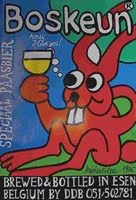Size: 330 ml
ABV: 8 %
It wasn’t that long ago that I had first tried the Achel Bruin (#200), and up next was the highly rated Blond. The previous tale I spun was around the history of the brewery, but one shouldn’t leave these beers without a good look at the Abbey itself.
The real origins of the Achelse Kluis began way back in the mid 17th Century, out in the isolated countryside of Achel, which was then a small Princedom belonging to Liege. Here was built a small chapel which served the community as a worshipping place for the Catholic people of the nearby Protestant Netherlands who were not allowed to worship there under the current regime. The roots of the Abbey itself stem from Petrus van Eynatten heading here fromEindhoven in 1686 and setting up a priory of hermits which soon began to lead a life of prayer and contemplation. This quiet remote area would have drifted on and on but for the French Revolution in 1789 which tore the heart and soul out of the place.
The priory was then sold into the private hands of Jan Diederik van Tuyll van Serooskerken, but monastic life would eventually return thanks to the Trappist monks from the Abbey of Westmalle who founded the Abbey of St. Benedict in 1846. They put all their energies into ramping up the agricultural infrastructure; largely by developing livestock farming and by replacing wasteland with arable soil. Achel was granted Abbey status in 1871 and from here on really began to prosper, and sister projects would eventually spring up at Echt, Diepenveen, Rochefort (#31) and even at Kasanza in Congo.
Life would remain pretty unchanged at Achel until 1917 when the invading Germans dismantled the brewery for copper – 750kg of the stuff. The monks left, and a new Abbey was eventually built between 1946 and 1952, although in 1989, just after brewing had recommenced on the premises, most of the land attached was sold to the Dutch National Forest Administration and the Flemish Government. What remains at the Abbey now is the final Trappist brewery, and a number of tertiary services which also include a small shop selling various paraphernalia, and a guesthouse.
Achel is often the most overlooked of the Trappist breweries, and I have to admit I haven’t been completely convinced up to now as to what all the fuss is about. I sat down to drink the Achel Blond the night before my stag weekend expecting something a little more grand. It was an enjoyably strong tripel which had a clean and crisp flavour but it certainly lacked any of the fire that you associate with the monastic brewers of Belgium. I began to wonder what this might have tasted like prior to World War I and ended up drifting off to sleep on the sofa.




















